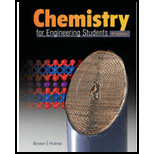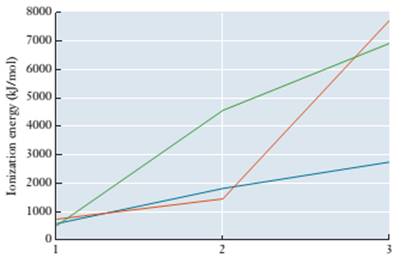
Bundle: Chemistry for Engineering Students, Loose-Leaf Version, 4th + OWLv2 with MindTap Reader with Student Solutions Manual, 1 term (6 months) Printed Access Card
4th Edition
ISBN: 9780357000403
Author: Lawrence S. Brown, Tom Holme
Publisher: Cengage Learning
expand_more
expand_more
format_list_bulleted
Textbook Question
Chapter 6, Problem 6.83PAE
6.83 The graph below shows the first three ionization energies for sodium, magnesium, and aluminum. Without consulting a list of values, determine which line in the graph corresponds to each element.

Number of electrons removed
Expert Solution & Answer
Trending nowThis is a popular solution!

Students have asked these similar questions
2.
200
LOD
For an unknown compound with a molecular ion of 101 m/z:
a.
Use the molecular ion to propose at least two molecular formulas. (show your work)
b.
What is the DU for each of your possible formulas? (show your work)
C.
Solve the structure and assign each of the following spectra.
8
6
4
2
(ppm)
150
100
50
ō (ppm)
4000
3000
2000
1500
1000
500
HAVENUMBERI-11
Complete the spectroscopy with structure
Complete the spectroscopy with structure
Chapter 6 Solutions
Bundle: Chemistry for Engineering Students, Loose-Leaf Version, 4th + OWLv2 with MindTap Reader with Student Solutions Manual, 1 term (6 months) Printed Access Card
Ch. 6 - describe trace analysis and explain its role in...Ch. 6 - describe waves in terms of frequency, wavelength,...Ch. 6 - Prob. 3COCh. 6 - relate the frequency, wavelength, and amplitude of...Ch. 6 - describe the photoelectric effect by stating what...Ch. 6 - Prob. 6COCh. 6 - • use Planck’s equation to calculate the energy of...Ch. 6 - Prob. 8COCh. 6 - Prob. 9COCh. 6 - • describe similarities and differences between...
Ch. 6 - Prob. 11COCh. 6 - Prob. 12COCh. 6 - • identify an orbital (as 1s, 3p, etc.) from its...Ch. 6 - • list the number of orbitals of each type (1s,...Ch. 6 - • sketch the shapes of s and p orbitals and...Ch. 6 - • rank various orbitals in terms of size and...Ch. 6 - Prob. 17COCh. 6 - Prob. 18COCh. 6 - Prob. 19COCh. 6 - Prob. 20COCh. 6 - Prob. 6.1PAECh. 6 - 6.2 Unlike XRF, AAS cannot be used for...Ch. 6 - Prob. 6.3PAECh. 6 - Prob. 6.4PAECh. 6 - Prob. 6.5PAECh. 6 - Prob. 6.6PAECh. 6 - 6.7 Arrange the following regions of the...Ch. 6 - 6.8 Calculate the wavelength in meters, of...Ch. 6 - 6.9 If a string of decorative lights includes...Ch. 6 - 6.10 Define the term refraction.Ch. 6 - 6.11 Define the term photon.Ch. 6 - 6.12 Find the energy of a photon with each of the...Ch. 6 - 6.13 Place these types of radiation in order of...Ch. 6 - 6.14 For photon with the following energies,...Ch. 6 - Prob. 6.15PAECh. 6 - 6.16 Various optical disk drives rely on laser...Ch. 6 - 6.17 The laser in most supermarket barcode...Ch. 6 - 6.18 Assume that a microwave oven operates at a...Ch. 6 - 6.19 Fill in the blanks below to complete a...Ch. 6 - 6.20 When light with a wavelength of 58.5 nm...Ch. 6 - 6.21 The electron binding energy fur copper metal...Ch. 6 - Prob. 6.22PAECh. 6 - 6.23 Describe how the Bohr model of the atom...Ch. 6 - 6.24 According to the Bohr model of the atom, what...Ch. 6 - 6.25 Define the term ground state.Ch. 6 - 6.26 The figure below depicts the first four...Ch. 6 - 6.27 Refer w the data and energy-Ievel diagram...Ch. 6 - 6.28 A neon atom cmi light at many wavelengths,...Ch. 6 - 6.29 A mercury atom emits light at many...Ch. 6 - 6.30 How did the observation of electron...Ch. 6 - 6.31 Why do we use a wave function to describe...Ch. 6 - 6.32 What are the mathematical origins of quantum...Ch. 6 - Prob. 6.33PAECh. 6 - 6.34 Which of the following represent valid sets...Ch. 6 - 6.35 A particular orbital has n = 4 and l = 2....Ch. 6 - 6.36 Why are there no 2d orbitals?Ch. 6 - 6.34 What is the maximum number of electrons in an...Ch. 6 - 6.38 How many orbitals correspond to each of the...Ch. 6 - Prob. 6.39PAECh. 6 - 6.40 Referring to Figure 6.15, draw a 4p orbitals,...Ch. 6 - 6.41 Consider a 3d orbital. (a) What are the...Ch. 6 - Prob. 6.42PAECh. 6 - 6.43 Define the term spin paired.Ch. 6 - 6.44 On what does the Pauli exclusion principle...Ch. 6 - Prob. 6.45PAECh. 6 - Prob. 6.46PAECh. 6 - 6.47 Depict two ways to place electrons in the 2p...Ch. 6 - 6.48 Write the ground state electron configuration...Ch. 6 - 6.49 Which of these electron configurations are...Ch. 6 - 6.50 From the list of atoms and ions given,...Ch. 6 - Prob. 6.51PAECh. 6 - Prob. 6.52PAECh. 6 - Prob. 6.53PAECh. 6 - Prob. 6.54PAECh. 6 - 6.55 Explain why the s block of the periodic table...Ch. 6 - Prob. 6.56PAECh. 6 - Prob. 6.57PAECh. 6 - Prob. 6.58PAECh. 6 - Prob. 6.59PAECh. 6 - 6.60 Use the electron configurations of the alkali...Ch. 6 - 6.61 Using only a periodic table as a guide,...Ch. 6 - 6.62 Define the term ionization energy....Ch. 6 - 6.63 At which ionization for chlorine would you...Ch. 6 - 6.64 Arrange the following atoms in order of...Ch. 6 - Prob. 6.65PAECh. 6 - 6.66 Which element would you expect to have the...Ch. 6 - Prob. 6.67PAECh. 6 - 6.68 Indicate which species in each pair has the...Ch. 6 - 6.69 Compare the elements Na, B, Al, and C with...Ch. 6 - 6.70 Rank the following in order of decreasing...Ch. 6 - 6.71 Several excited states of the neon atom are...Ch. 6 - 6.72 LED bulbs offer a fairly new lighting...Ch. 6 - 6.73 How much energy could be saved each year by...Ch. 6 - Prob. 6.74PAECh. 6 - Prob. 6.75PAECh. 6 - Prob. 6.76PAECh. 6 - Prob. 6.77PAECh. 6 - Prob. 6.78PAECh. 6 - 6.79 How does the charge of electrons provide some...Ch. 6 - 6.80 Describe how valence electron configurations...Ch. 6 - 6.81 Why is there no element to the immediate...Ch. 6 - 6.82 A particular element has the following values...Ch. 6 - 6.83 The graph below shows the first three...Ch. 6 - 6.84 Which graph correctly depicts the first...Ch. 6 - 6.85 The visible lines in the hydrogen atom...Ch. 6 - 6.86 An excited He+ ion returns to the ground...Ch. 6 - Prob. 6.87PAECh. 6 - Prob. 6.88PAECh. 6 - Prob. 6.89PAECh. 6 - Prob. 6.90PAECh. 6 - 6.91 What is the only noble gas that does not have...Ch. 6 - 6.92 The photoelectric effect can he used to...Ch. 6 - 6.93 A mercury atom is initially in its lowest...Ch. 6 - Prob. 6.94PAECh. 6 - 6.95 A metallic sample is known to be barium,...Ch. 6 - 6.96 When a helium atom absorbs light at 58.44 nm,...Ch. 6 - 6.97 Arrange the members of each of the following...Ch. 6 - 6.98 Arrange the following sets of anions in order...Ch. 6 - 6.99 The photoelectric effect can he used in...Ch. 6 - 6.100 Some spacecraft use ion propulsion engines....Ch. 6 - 6.101 Laser welding is a technique in which a...Ch. 6 - Prob. 6.102PAECh. 6 - 6.103 Atomic absorption spectroscopy is based on...Ch. 6 - 6.104 The red color in fireworks is the result of...Ch. 6 - 6.105 When we say that the existence of atomic...Ch. 6 - 6.106 When Bohr devised his model for the atom,...Ch. 6 - Prob. 6.107PAE
Knowledge Booster
Learn more about
Need a deep-dive on the concept behind this application? Look no further. Learn more about this topic, chemistry and related others by exploring similar questions and additional content below.Similar questions
- Given the following concentrations for a system, calculate the value for the reaction quotient: Cl2(g)+ CS2(g) ⇌ CCl4(g)+ S2Cl2(g) Cl2 = 31.1 atm CS2 = 91.2 atm CCl4 = 2.12 atm S2Cl2 = 10.4 atmarrow_forwardMatch each chemical or item with the proper disposal or cleanup mwthod, Not all disposal and cleanup methods will be labeled. Metal sheets C, calcium, choroide solutions part A, damp metal pieces Part B, volumetric flask part A. a.Return to correct lables”drying out breaker. Place used items in the drawer.: Rinse with deionized water, dry as best you can, return to instructor. Return used material to the instructor.: Pour down the sink with planty of running water.: f.Pour into aqueous waste container. g.Places used items in garbage.arrow_forwardWrite the equilibrium constant expression for the following reaction: HNO2(aq) + H2O(l) ⇌ H3O+(aq) + NO2-(aq)arrow_forward
arrow_back_ios
SEE MORE QUESTIONS
arrow_forward_ios
Recommended textbooks for you
 Chemistry for Engineering StudentsChemistryISBN:9781337398909Author:Lawrence S. Brown, Tom HolmePublisher:Cengage Learning
Chemistry for Engineering StudentsChemistryISBN:9781337398909Author:Lawrence S. Brown, Tom HolmePublisher:Cengage Learning
 Chemistry: The Molecular ScienceChemistryISBN:9781285199047Author:John W. Moore, Conrad L. StanitskiPublisher:Cengage Learning
Chemistry: The Molecular ScienceChemistryISBN:9781285199047Author:John W. Moore, Conrad L. StanitskiPublisher:Cengage Learning Living By Chemistry: First Edition TextbookChemistryISBN:9781559539418Author:Angelica StacyPublisher:MAC HIGHER
Living By Chemistry: First Edition TextbookChemistryISBN:9781559539418Author:Angelica StacyPublisher:MAC HIGHER Introductory Chemistry: An Active Learning Approa...ChemistryISBN:9781305079250Author:Mark S. Cracolice, Ed PetersPublisher:Cengage LearningChemistry: Matter and ChangeChemistryISBN:9780078746376Author:Dinah Zike, Laurel Dingrando, Nicholas Hainen, Cheryl WistromPublisher:Glencoe/McGraw-Hill School Pub Co
Introductory Chemistry: An Active Learning Approa...ChemistryISBN:9781305079250Author:Mark S. Cracolice, Ed PetersPublisher:Cengage LearningChemistry: Matter and ChangeChemistryISBN:9780078746376Author:Dinah Zike, Laurel Dingrando, Nicholas Hainen, Cheryl WistromPublisher:Glencoe/McGraw-Hill School Pub Co

Chemistry for Engineering Students
Chemistry
ISBN:9781337398909
Author:Lawrence S. Brown, Tom Holme
Publisher:Cengage Learning


Chemistry: The Molecular Science
Chemistry
ISBN:9781285199047
Author:John W. Moore, Conrad L. Stanitski
Publisher:Cengage Learning

Living By Chemistry: First Edition Textbook
Chemistry
ISBN:9781559539418
Author:Angelica Stacy
Publisher:MAC HIGHER

Introductory Chemistry: An Active Learning Approa...
Chemistry
ISBN:9781305079250
Author:Mark S. Cracolice, Ed Peters
Publisher:Cengage Learning

Chemistry: Matter and Change
Chemistry
ISBN:9780078746376
Author:Dinah Zike, Laurel Dingrando, Nicholas Hainen, Cheryl Wistrom
Publisher:Glencoe/McGraw-Hill School Pub Co
Quantum Numbers, Atomic Orbitals, and Electron Configurations; Author: Professor Dave Explains;https://www.youtube.com/watch?v=Aoi4j8es4gQ;License: Standard YouTube License, CC-BY
QUANTUM MECHANICAL MODEL/Atomic Structure-21E; Author: H to O Chemistry;https://www.youtube.com/watch?v=mYHNUy5hPQE;License: Standard YouTube License, CC-BY